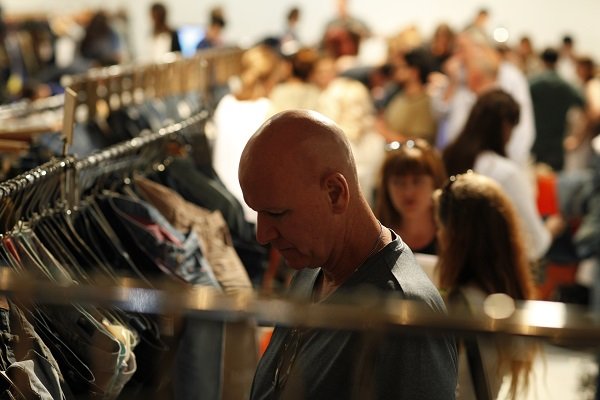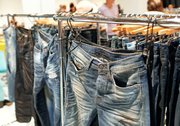DENIM FOCUS: Kingpins, the boutique trade show focused on all aspects of the denim supply chain, celebrated its 10-year anniversary during the show’s July 22–23 run at Skylight Clarkson Square in New York.
TRADE SHOW
UPDATED: Kingpins at 10: Curated Denim Selection
NEW YORK—It’s not the typical trade show—small, invitation-only, chill music, with funky wooden tables and benches and neon-colored velvet ottomans for the booths. Not to mention lots of great food and drink, including trays of tea sandwiches offered by a roving waiter at day’s end.
Andrew Olah, the founder and organizer of Kingpins, a show devoted to all things denim, celebrated the event’s 10th anniversary this year. A low-key Canadian originally from Toronto, Olah prides himself on creating a welcoming place where industry veterans can meet, work and play.
“We have the best party,” he said—given that Première Vision New York and Texworld USA were also being held in New York the same week. “This seems to be one of our best shows ever. It’s very well thought of.” With only 65 exhibitors, Olah curates an atmosphere conducive to productive business.
“We don’t want networkers or competitors. We really don’t want those people,” he said. “We only invite academia, media, exhibitors and buyers. It’s not a social function.”
“This is the only show we do,” said Kent Pellegrini, a partner in Walnut Creek, Calif.–based Nexgen Packaging, which makes labels and hangtags for Ralph Lauren, G.H. Bass, Allsaints and many others. (Kingpins does two shows a year in LA, two in New York, two in Hong Kong, two in Amsterdam and one in Shanghai.)
Designers want to message authenticity in every detail, said Debbie Bougas of Nexgen.
“The environmental story is still strong when it comes to packaging. There’s a new freshness to vintage, but there needs to be a legitimate backstory to it.” She pointed to San Francisco–based jeans maker Tellason, an 8-year-old firm trading heavily on the heritage of its building, the city and its product. “They’re one of the best when it comes to authenticity.”
Designers are also hyper-fussy when it comes to these smallest of final details, Pellegrini says. “Jay-Z will even sign off on the tag. It’s a passionate business.”
The current challenge for designers and producers such as Nexgen is integrating RFID (radio frequency identification) technology with great tag and label design, Pellegrini added. “It’s coming and we’re doing it, but what’s the best way to use it without distracting the consumer?”
Kara Nichols, vice president of product development and marketing for 118-year-old Cone Denim, said the big story is sustainability. The firm recently introduced ConeTouch, a denim made by Unifi Inc. from recycled bottles—each pair of jeans made using the fabric contains an average of eight recycled bottles. The fabric uses Repreve, a stretch yarn also made from recycled plastic bottles.
And the company’s new yarn pretreatment process, VaraBlue, also reduces water and energy use, along with reductions in effluents released into the environment. The dyes are applied to the garment after it’s sewn, allowing the development of any color with very small minimums.
“It’s very different from traditional dye. The color doesn’t penetrate to the same depth, so it gives a more weathered look,” she explained. “We’re offering color in a very different way than customers have in their closet already. We’ve been getting a very good reaction from our customers, and we’ve gotten a lot of sample orders.”
Kaltex, the largest denim manufacturer in the Western Hemisphere, offered laser-printed denim as one of its newest fabrics. For men, “comfort stretch is very important,” said Roberto Rosenberg. For men and women, “black is going to be important, as are rip and repair concepts and high contrast.” They are now also using laser printing. Instead of having whiskers applied manually using sandpaper, the company’s 11 $350,000 Spanish-made machines will create similar effects more quickly and less expensively.
After 50 years in the pocket business, buyers are still opting—75 percent of them—for plain white fabric, said Barry Emanuel, president of Copen United Ltd. But a new stretch fabric will make for smoother lines and better flexibility when used for the pockets in stretch jeans. “Every important company is doing it or thinking of doing it,” he said.
Although most people would never be able to find his company’s San Marino headquarters on a map, Alberto De Conti, managing director of The Italian Job, works to help designers create new looks with denim. In concert with Garmon, he helps brands such as Levi’s, Diesel, Hugo Boss and G-STAR stay ahead of the style curve. “We look for the latest advancements in chemistry and apply them to fashion,” he said.
A recent example is FST RW, which can be sprayed onto fabric to retain the original color and appearance of raw denim. After washing, the unsprayed areas fade out. “This is a bit of a revolution. It resists washing, but it also allows for abrasion to happen. This is something we expect to see in the market in a few years. The purists are especially interested in this.”
Resins with no formaldehyde (some of them originally used in the food industry), and a new dyeing technique called Surf, are other examples of latest chemical innovations. Surface dyeing effects can be created in any color and are most popular with fashion-forward European brands. “We’ve had a really, really good reaction,” De Conti said.
At Denimatrix, 25-year industry veteran Ralph Tharpe, who works in product development, said that Repreve is helping to solve “a problem we’ve been fighting in the denim world”—that stretch fabrics stretch out but don’t stretch as well back into shape.
Another ongoing challenge is the shrinking of denim production to only four American mills, two in North Carolina, one in South Carolina and one in Texas. “It’s hard for a U.S. mill to compete,” he said. “The only way to survive is to go upscale because the Mexican, Pakistani and Chinese mills are going upscale every day. Our industry has been capital starved because all the work has moved offshore.”
Chris Price of Bluefarm Textiles, makers of shirting and blends from Taiwan and China, showed a thick sweater knitted using herringbone indigo yarns. It prompted an “amazing reaction” from buyers, he said. “Beautiful indigo knits are hard to find.” His firm is focused on “the evolution of indigo out of traditional use into dobbies and lighter-weight fabrics like silk, Modal and cashmere.” One of his samples was a super-lightweight 2-ounce cotton used for shirting.
“Indigo is moving from bottoms to tops,” he said. He also showed textiles using space dye, on which the weft yarn is unevenly dyed. “Space dyes and jaspé have been big for us.”
“It was a really, really good show,” he said.
























